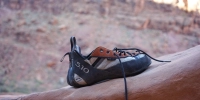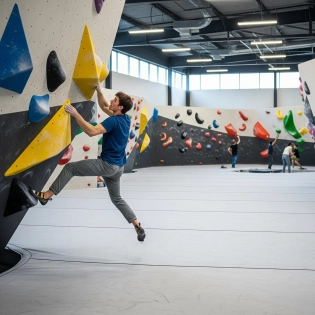







Climbers Point
When rock climbers go on multi-day climbing trips or expeditions, they need to find a way to sleep in the outdoor environment. Here are a few common methods rock climbers use for sleeping:
-
Camping: Rock climbers often bring camping gear, such as a tent, sleeping bag, and sleeping pad, to set up a campsite at the base of the climbing area or at a nearby campground. This provides a comfortable and protected sleeping space, shielded from the elements.
-
Bivouacking (Bivy): In more remote or alpine climbing settings where weight and portability are crucial, climbers may choose to bivouac. This involves using lightweight bivy sacks or small portable shelters that provide minimal protection against the elements. Bivying allows climbers to sleep directly on the mountainside or in a small ledge, minimizing the gear they need to carry.
-
Huts or Shelters: In certain climbing areas, there may be mountain huts or shelters available for climbers to sleep in. These accommodations often require reservations and provide a more comfortable and sheltered sleeping option, especially in harsh weather conditions.
-
Portaledges: For big wall climbing, where climbers spend multiple days ascending large vertical faces, specialized portable hanging tents called "portaledges" are used. Portaledges are suspended from the rock face using anchors and offer a stable and secure sleeping platform.
It's important to note that the sleeping arrangements for rock climbers largely depend on the climbing environment, the duration of the climb, and personal preferences. Safety, comfort, and protection from the elements are key considerations when choosing a sleeping method. Additionally, climbers must adhere to any regulations or guidelines set by the climbing area or national park they are in.
When rock climbers need to get their rope up a route, they typically use a technique called "lead climbing." Here's a brief overview of the process:
-
Preparing the Gear: The climber carries a climbing rope, quickdraws (sets of connected carabiners), and any necessary protective gear like cams or nuts.
-
Tying In: The climber ties one end of the rope to their climbing harness using a secure knot, such as a figure-eight follow-through or a double fisherman's knot.
-
Lead Climbing: The climber starts ascending the route, placing protective gear as they climb. They clip the rope through the quickdraws, which are attached to the bolts or anchors on the wall.
-
Rope Management: As the climber progresses, they manage the rope by periodically pulling up slack and securing it with a series of rope clips or by using techniques like "clipping long" or "short."
-
Anchor Setup: Once the climber reaches the top or desired stopping point, they set up an anchor using webbing, slings, or specialized anchor gear. This allows them to secure themselves and the rope for subsequent climbers or for rappelling.
It's worth noting that lead climbing requires knowledge of climbing techniques, equipment usage, and rope management skills. Proper training, experience, and understanding of safety protocols are crucial for lead climbing. Climbers often receive instruction from experienced climbers or take courses to learn and practice these skills safely.
It's also important to remember that climbing is inherently risky, and the information provided here is a general overview. It's recommended to seek guidance from experienced climbers, take professional instruction, and always prioritize safety when engaging in rock climbing activities.
Alle, or Allez, is a form of encouragement in climbing. It means "go" or "come one" in French.
When people shout "allez" at others, it's the same as shouting "come on", "you can do it", it's just a form of encouragement that is very common in climbing.
Different countries and languages may have their own word of encouragement besides allez, but I think that alle is by far the most common.
Climbers often use the term "allez" as a form of encouragement or motivation during a climb. While it may sound similar to the word "alle" in French, its usage in climbing is not directly related to its meaning in the French language.
In the climbing context, "allez" is typically shouted or exclaimed to cheer on a fellow climber, especially in a sport climbing or bouldering setting. It serves as a way to provide support, push someone to give their best effort, and create a positive and motivating atmosphere. When climbers hear "allez," it can inspire them to keep pushing through difficult sections or to summon the determination needed to complete a challenging climb.
While it's not a universal term used by all climbers, "allez" has become a common expression within the climbing community, representing encouragement and enthusiasm during the climbing process.
Rock climbing offers a range of physical, mental, and social benefits. Here are some of the key benefits of rock climbing:
-
Physical Fitness: Rock climbing is a demanding physical activity that engages the entire body. It helps to build strength in the arms, back, core, and leg muscles. Climbing also improves endurance, flexibility, and coordination.
-
Mental Strength and Problem-Solving: Climbing requires mental focus, problem-solving skills, and the ability to make quick decisions. It challenges your mind as you analyze routes, find the best holds, and overcome obstacles. Climbing can enhance concentration, decision-making abilities, and mental resilience.
-
Full-Body Workout: Climbing involves a variety of movements, such as pulling, pushing, balancing, and twisting. It provides a comprehensive workout for your muscles, including those in your upper body, lower body, and core. Climbing also improves grip strength and finger dexterity.
-
Stress Relief and Mindfulness: Rock climbing can serve as a form of stress relief and a way to escape daily pressures. Focusing on the climb and being in the present moment can promote mindfulness and a sense of calm. Being in nature and experiencing the outdoors can also contribute to relaxation and well-being.
-
Social Interaction and Community: Climbing is often done in a social setting, whether it's with friends at a climbing gym or joining outdoor climbing groups. It can foster a sense of camaraderie, teamwork, and support among climbers. The climbing community is known for its inclusivity and encouragement.
-
Overcoming Fears and Building Confidence: Climbing challenges you to face your fears, whether it's fear of heights, falling, or pushing your limits. As you conquer challenges and achieve goals, climbing can boost self-confidence, resilience, and personal growth.
The four main types of climbing are:
-
Sport Climbing: This type of climbing involves ascending routes that have pre-placed protection, such as bolts or anchors, for clipping the rope. Sport climbing focuses on the physical and technical aspects of climbing, with an emphasis on difficulty and pushing personal limits.
-
Trad Climbing (Traditional Climbing): Trad climbing is a style of climbing where the climber places their own protection, such as cams, nuts, and slings, into natural features of the rock. Trad climbing requires knowledge of gear placement and anchor building skills.
-
Bouldering: Bouldering is a form of climbing that is typically done on shorter routes or boulders without the use of ropes or harnesses. Climbers rely on crash pads for protection and focus on solving complex, dynamic, and powerful movements close to the ground.
-
Alpine Climbing: Alpine climbing takes place in high-mountain environments and involves a combination of climbing, hiking, and mountaineering skills. It often includes long approaches, variable weather conditions, and the use of specialized equipment such as crampons and ice axes.
These are the four main types of climbing, each with its own unique characteristics and challenges. Keep in mind that there are also sub-disciplines and variations within these types of climbing, but these four categories provide a broad overview of the different styles of climbing.
When it comes to rock climbing specifically, there are several climbers who have made significant contributions and achieved remarkable feats. It's challenging to pinpoint a single greatest rock climber, as different climbers excel in different styles and areas of the sport. However, if I were to mention a few names that are often regarded as some of the greatest rock climbers, they would include Alex Honnold, Tommy Caldwell, Lynn Hill, and Adam Ondra. These climbers have pushed the boundaries of what is considered possible in rock climbing, accomplishing groundbreaking ascents and inspiring generations of climbers. Ultimately, the title of the greatest rock climber is subjective and can vary depending on personal preferences and criteria.
To strengthen tendons, it's important to approach it gradually and allow sufficient time for the tendons to adapt and grow stronger. Here are a few tips:
Gradual Progression: Start with lower-intensity exercises or movements that target the specific tendon you want to strengthen. Gradually increase the intensity, duration, or resistance over time. Avoid jumping into high-impact or high-load activities too quickly, as it can strain the tendons and lead to injuries.
Eccentric Exercises: Eccentric exercises focus on the lengthening phase of a movement. They have been shown to be effective in strengthening tendons. For example, slowly lowering a weight or resisting the movement against gravity can help strengthen tendons. Consult with a qualified trainer or physical therapist to learn proper techniques for specific exercises.
Proper Nutrition: Ensure you have a well-balanced diet that includes adequate protein, which is essential for tendon health and repair. Also, consider including foods rich in collagen-building nutrients, such as vitamin C, zinc, and copper.
Rest and Recovery: Allow enough time for rest and recovery between tendon-strengthening exercises or training sessions. Tendons require time to repair and adapt to the demands placed upon them. Overtraining or insufficient rest can hinder tendon strength and increase the risk of injury.
Listen to Your Body: Pay attention to any signs of pain, discomfort, or inflammation. If you experience persistent or severe pain, it's crucial to seek medical advice from a healthcare professional or physical therapist who can evaluate your specific situation and provide tailored recommendations.
Remember, tendon strengthening is a gradual process, and it's important to prioritize safety and avoid overloading the tendons, as they can take longer to adapt compared to muscles.
When do you feel your shoes are slippery? Is it when you are climbing on slabs, or in general when placing your foot on a hold even in an overhang?
I have a pair of shoes that feel extremely slippery, it's so bad that I have barely worn them for the past few years, they are basically new. They slip on almost every thing I try to stand on, regardless of if it's a slab or even a volume thats on a neutral flat wall. I thought maybe it was because of me not committing or trusting my feet (hence why I ask if it's only when you are climbing on slabs), but when I used my other shoes they stuck like magic.
The soles of my shoes are very smooth and hard, it feels almost like plastic in a way. I believe this is what is causing me to slip. My thought is to just send them in for either a resole (even though they are new and have no damage because I never wore them), or to get them roughened up a bit, I think there is a service for that as well.





